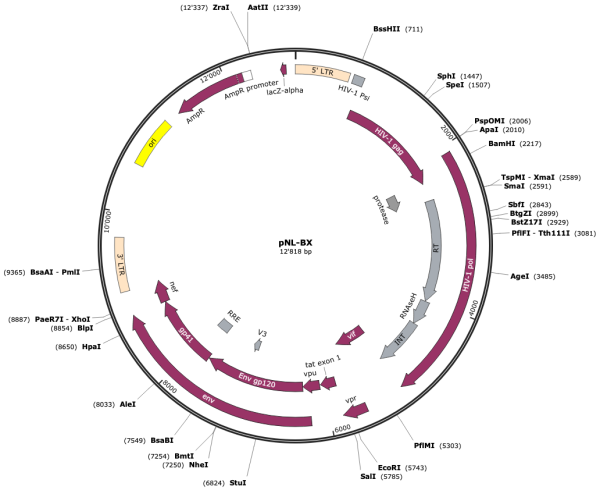Product Description
Ref-SKU:
007N-05791 full length plasmid clone of proviral HIV-1; construct produces fully infectious HIV-1 upon transfection into eukaryotic cells; based on NL-BX
Product Risk Group:
Information on the related virus
ICTV Taxonomy:
Virus name:
Strain:
Isolate:
Cloned Product: Yes
Special feature:
Can it be used to produce GMO:
No
Biosafety restrictions:
Upon transfection of eukaryotic cells DNA can produce infectious virus causing disease in humans
Region encompassed in this Product:
entire genome
Plasmid:
Plasmid selection:
TAG:
Sequencing:
Fully sequenced
Sequence checked:
Yes
Mutations:
Contain mutations (no frameshift, no unexpected STOP codon)
Observed mutations:
mutation as indicated in the name; backbone is NL-BX:
The virus genome is derived from pNL-NF (pNL4-3 with shortened cellular flank) (doi.org/10.1016/j.jcv.2006.05.001), after introduction of a unique BamHI site 5’ (ggagcc2207ggaTcc; A->S in Pol; E->D in Gag) and an XmaI site 3’ (ccagga2589ccCggG; silent in Env; L->S in Rev) from the protease gene, respectively. The original BamHI site as position 8465 was removed (GGATCC->GGATCA change)
.gb file of the construct:
Identification technique:
restriction digest (Hind III), partial sequencing
Nucleic Acid preparation technique:
solid phase column extraction
Storage conditions:
TE Buffer -20C
Shipping conditions:
IATA Classification:
Virus host type:
Note:
To show the resistance pattern to antiretroviral drugs caused by the mutations present in this viral clone, use e.g. the „mutations list analysis“ function of the public HIV-Grade site at:
Information about the origin of the product
Recombinant product:
This product is a recombinant product
Biological material origin:
Synthetic origin & Natural origin
Natural part identification: derived from the proviral clone NL4-3
Natural part identification:
derived from the proviral clone NL4-3
Genbank reference:
Collection date: BEFORE
Friday, 1 January, 2010
Country of collection:
Synthetic part identification: Generated from pNL4-3, lacking most of cellular flank (size 12.8 kbp)
Synthetic part identification:
Generated from pNL4-3, lacking most of cellular flank (size 12.8 kbp)
Modifications from the reference sequence(s):
The sequence(s) of this synthetic product has been modified from the sequence listing provided as Genbank references
Description of modification(s) made from the reference sequence(s):
PCR-based mutagenesis; carries the indicated mutation(s) in the target gene as shown in the product name
